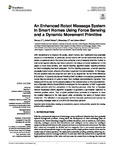An Enhanced Robot Massage System in Smart Homes Using Force Sensing and Dynamic Movement Primitive
| dc.contributor.author | Li, C | |
| dc.contributor.author | Fahmy, A | |
| dc.contributor.author | Li, S | |
| dc.contributor.author | Sienz, J | |
| dc.date.accessioned | 2020-07-09T05:28:32Z | |
| dc.date.issued | 2020-06-29 | |
| dc.identifier.issn | 1662-5218 | |
| dc.identifier.issn | 1662-5218 | |
| dc.identifier.other | ARTN 30 | |
| dc.identifier.uri | http://hdl.handle.net/10026.1/15857 | |
| dc.description.abstract |
With requirements to improve life quality, smart homes, and healthcare have gradually become a future lifestyle. In particular, service robots with human behavioral sensing for private or personal use in the home have attracted a lot of research attention thanks to their advantages in relieving high labor costs and the fatigue of human assistance. In this paper, a novel force-sensing- and robotic learning algorithm-based teaching interface for robot massaging has been proposed. For the teaching purposes, a human operator physically holds the end-effector of the robot to perform the demonstration. At this stage, the end position data are outputted and sent to be segmented via the Finite Difference (FD) method. A Dynamic Movement Primitive (DMP) is utilized to model and generalize the human-like movements. In order to learn from multiple demonstrations, Dynamic Time Warping (DTW) is used for the preprocessing of the data recorded on the robot platform, and a Gaussian Mixture Model (GMM) is employed for the evaluation of DMP to generate multiple patterns after the completion of the teaching process. After that, a Gaussian Mixture Regression (GMR) algorithm is applied to generate a synthesized trajectory to minimize position errors. Then a hybrid position/force controller is integrated to track the desired trajectory in the task space while considering the safety of human-robot interaction. The validation of our proposed method has been performed and proved by conducting massage tasks on a KUKA LBR iiwa robot platform. | |
| dc.format.extent | 30- | |
| dc.format.medium | Electronic-eCollection | |
| dc.language | eng | |
| dc.language.iso | en | |
| dc.publisher | Frontiers Media | |
| dc.subject | hybrid force | |
| dc.subject | position | |
| dc.subject | teaching by demonstration | |
| dc.subject | dynamic motion primitive | |
| dc.subject | dynamic time warping | |
| dc.subject | gaussian mixture regression | |
| dc.title | An Enhanced Robot Massage System in Smart Homes Using Force Sensing and Dynamic Movement Primitive | |
| dc.type | journal-article | |
| dc.type | Article | |
| plymouth.author-url | https://www.ncbi.nlm.nih.gov/pubmed/32714174 | |
| plymouth.volume | 14 | |
| plymouth.publication-status | Published online | |
| plymouth.journal | Frontiers in Neurorobotics | |
| dc.identifier.doi | 10.3389/fnbot.2020.00030 | |
| plymouth.organisational-group | /Plymouth | |
| plymouth.organisational-group | /Plymouth/Faculty of Science and Engineering | |
| plymouth.organisational-group | /Plymouth/Faculty of Science and Engineering/School of Engineering, Computing and Mathematics | |
| plymouth.organisational-group | /Plymouth/REF 2021 Researchers by UoA | |
| plymouth.organisational-group | /Plymouth/REF 2021 Researchers by UoA/UoA11 Computer Science and Informatics | |
| plymouth.organisational-group | /Plymouth/Users by role | |
| plymouth.organisational-group | /Plymouth/Users by role/Academics | |
| dc.publisher.place | Switzerland | |
| dcterms.dateAccepted | 2020-05-04 | |
| dc.rights.embargodate | 2020-7-10 | |
| dc.identifier.eissn | 1662-5218 | |
| dc.rights.embargoperiod | Not known | |
| rioxxterms.versionofrecord | 10.3389/fnbot.2020.00030 | |
| rioxxterms.licenseref.uri | http://www.rioxx.net/licenses/all-rights-reserved | |
| rioxxterms.licenseref.startdate | 2020-06-29 | |
| rioxxterms.type | Journal Article/Review |


